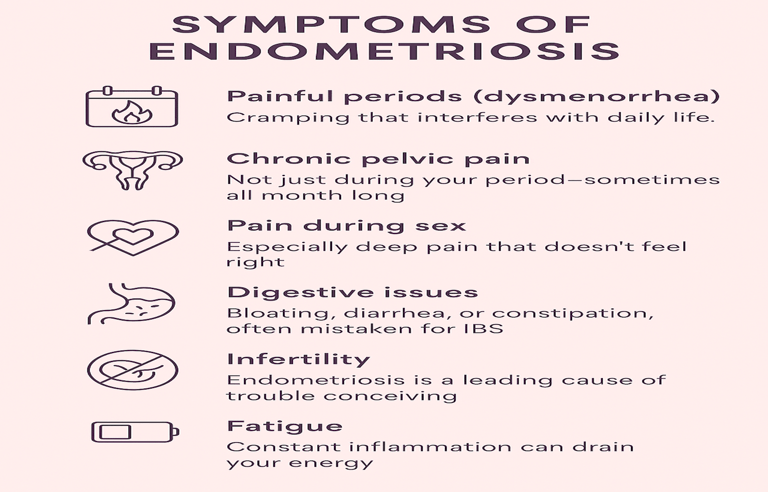Stay updated on what is trending in health. Discover tips and resources for a healthier, balanced life.
Endometriosis: What Every Woman Should Know
Learn the common symptoms of endometriosis—from painful periods to digestive issues and infertility. Understand the red flags and when to seek help for this often-misunderstood condition.
DISEASES AND CONDITIONS
Dr. S. Ali
9/18/20254 min read


Endometriosis affects millions of women around the world, but many still suffer in silence, undiagnosed or misunderstood. If you've ever wondered why your periods are so painful, or why you're struggling with fertility, it might be time to look into this often-overlooked condition.
What Is Endometriosis?
Endometriosis (or “endo,” as many call it) is a chronic condition where tissue similar to the lining of your uterus starts growing outside the uterus. Think ovaries, fallopian tubes, bladder, bowel—even areas far beyond the pelvis. This tissue acts just like your normal uterine lining: it builds up and sheds with your cycle. But here’s the catch—it has nowhere to go. That can lead to inflammation, scarring, cysts, and serious pain.
Common Symptoms of Endometriosis
Symptoms can vary, but here are some of the most common red flags:
Painful periods (dysmenorrhea):
Cramping that interferes with daily life is not normal. If you find yourself curled up in bed or relying heavily on painkillers each month, that’s a sign something deeper might be going on.Chronic pelvic pain:
This isn’t just a few days of discomfort—it’s a lingering, often sharp or aching pain that can show up anytime, even outside your cycle. It may feel like a constant heaviness or burning in your lower abdomen.Pain during sex:
Especially deep pain that doesn’t feel right. It might occur during or after intercourse and can affect intimacy, relationships, and your sense of well-being.Digestive issues:
Bloating, diarrhea, or constipation, often mistaken for Irriable Bowel Syndrome (IBS). Some women even call it “endo belly” because the bloating can become so severe it mimics pregnancy or makes clothes feel tight by the end of the day.Infertility:
Endometriosis is a leading cause of trouble for conceiving. It can block fallopian tubes, affect egg quality, or cause inflammation that interferes with conception—even if your cycle seems “regular.”Fatigue:
Constant inflammation can drain your energy. Many women describe feeling chronically exhausted, mentally foggy, or “wiped out,” even after a full night’s sleep.
Not everyone with endometriosis will experience all these symptoms—and some may have no symptoms at all. That’s what makes early diagnosis so challenging and important.
What Causes Endometriosis?
Doctors don’t know the exact cause, but a few theories include:
Retrograde menstruation: When menstrual blood flows backward into the pelvic cavity instead of exiting the body. This backward flow can carry endometrial cells, which may then implant on pelvic organs and continue to grow. It’s one of the most widely accepted theories, but not all women with retrograde menstruation develop endometriosis.
Hormonal imbalances and immune dysfunction: Estrogen dominance and immune system irregularities might allow endometrial tissue to grow outside the uterus unchecked. A sluggish immune response may fail to recognize and eliminate misplaced endometrial cells.
Genetics: It often runs in families. If your mother, sister, or aunt has endometriosis, your risk may be significantly higher. Certain genetic variations are being studied as potential links.
Surgical scars: Endometrial cells can attach to surgical sites like those from a C-section, hysterectomy, or other abdominal procedures. These cells may become activated post-surgery and start forming lesions.
👉 Whatever the cause, one thing’s clear: it’s not in your head. Endometriosis is a real, chronic medical condition that deserves attention and proper care.
How Is It Diagnosed?
Endometriosis can be tricky to diagnose. Symptoms often mimic other conditions, and many women are told their pain is “just part of being a woman.”
Doctors may use:
Pelvic exams – A manual exam to check for enlarged or tender areas in the pelvic region.
→ While it can’t confirm endometriosis, it may reveal signs that prompt further testing.Ultrasound or MRI – Imaging tests that help detect cysts (endometriomas) or other abnormalities.
→ These scans can’t visualize all endometrial tissue but may support the diagnosis process.Laparoscopy (a minor surgery) – This is the gold standard for a confirmed diagnosis.
→ A small camera is inserted through a tiny incision to directly see and sometimes remove endometrial tissue.
Diagnosis often takes years, so advocating for yourself is key.
Keep a symptom diary, seek second opinions if needed, and don’t hesitate to ask questions.
How Is Endometriosis Treated?
There’s no cure (yet), but there are ways to manage it:
1. Pain Relief
Nonsteroidal anti-inflammatory drugs (NSAIDs) like ibuprofen can help, but aren’t always enough. They reduce pain and inflammation, but don’t treat the underlying endometrial growth.
2. Hormonal Therapy
Birth control pills, intrauterine devices (IUDs), or gonadotropin-releasing hormone (GnRH) agonists can help slow or stop the abnormal tissue growth. These hormonal treatments reduce estrogen levels, which fuels the growth of endometrial tissue.
3. Surgery
Laparoscopic excision removes endometrial lesions and can provide major relief. It’s often used when medications aren’t effective or if fertility is a concern. Recovery time is usually short, and many people experience lasting pain relief.
4. Lifestyle Changes
Anti-inflammatory diets, stress management, and pelvic physical therapy can all support symptom control. While not a cure, these approaches can reduce flare-ups, improve overall well-being, and complement medical treatment.
5. Fertility Support
If you're trying to conceive, a fertility specialist can help guide next steps. Options may include ovulation-stimulating medications, intrauterine insemination (IUI), or in vitro fertilization (IVF), depending on your situation.
Living with Endometriosis
Living with a chronic illness like endo can be exhausting. It’s not just physical pain—it’s missed work, social events, and sometimes feeling like you’re not being taken seriously. Connecting with support groups or an endometriosis specialist can be life-changing.
Don’t Ignore the Signs
If you feel like your period pain is more than what’s normal—or your gut tells you something isn’t right—listen to your body. Early diagnosis and proactive care can make a big difference in your quality of life.
Sources:
National Institute of Child Health and Human Development
https://www.nichd.nih.gov/health/topics/endometri/conditioninfo/symptoms youtube.com+15nichd.nih.gov+15verywellhealth.com+15nichd.nih.govWorld Health Organization (WHO) – Endometriosis Fact Sheet
https://www.who.int/news-room/fact-sheets/detail/endometriosis who.intMayo Clinic – Endometriosis: Symptoms & Causes
https://www.mayoclinic.org/diseases-conditions/endometriosis/symptoms-causes/syc-20354656 nature.com+1nichd.nih.gov+1mayoclinic.org+1mayoclinic.org+1Cleveland Clinic – Endometriosis Overview
https://my.clevelandclinic.org/health/diseases/10857-endometriosis en.wikipedia.org+15my.clevelandclinic.org+15youtube.com+15MedlinePlus – Endometriosis Overview
https://medlineplus.gov/endometriosis.html
Pulse Your Health
Empowering you to achieve your health goals.
Contact
© 2025. All rights reserved.
Disclaimer: The content on this website is for informational purposes only and is not medical advice. Always seek the advice of your physician or other suitably qualified healthcare professional for diagnosis, treatment and your health related needs.
